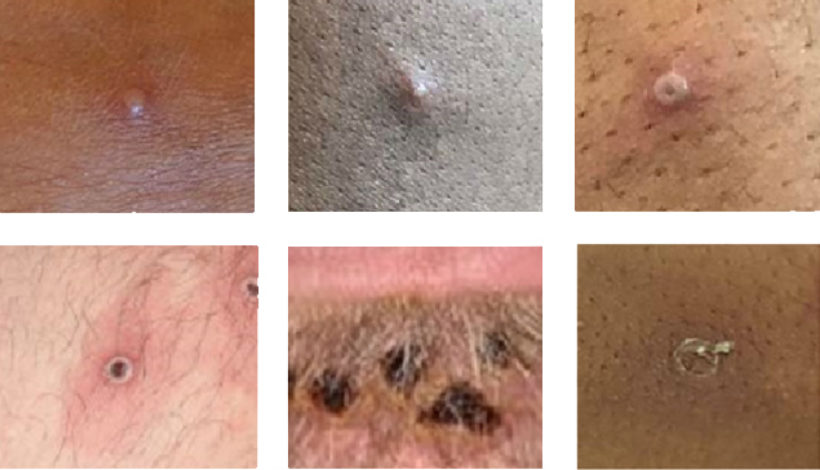Mpox (monkeypox) is a rare disease caused by infection with the mpox virus. Mpox was first identified in 1958 when two outbreaks of pox-like disease occurred in colonies of research monkeys. The source of mpox is unknown.
Mpox is a disease caused by the mpox virus, which belongs to the Orthopoxvirus genus. This genus also includes variola virus, which causes smallpox, and vaccinia virus (used in the smallpox vaccine), and cowpox virus. However, mpox is not related to chickenpox.
Mpox is a zoonosis, which is a disease that is transmitted from animals to humans. Mpox occurs in rodents and non-human primates and is generally found in central and West Africa. The first human case of mpox was observed in 1970.
The last mpox outbreak in the United States occurred in 2003. Forty-seven people located primarily in the Midwest were infected through contact with domestic prairie dogs. The prairie dogs were exposed to an infected Gambian pouched rat imported from Ghana while living in a shared space in a pet store.
Until 2022, most cases of mpox that occurred outside of Africa were related to people traveling internationally or the import of animals from places where the disease is more common. In 2022, multiple mpox cases were reported in several countries worldwide where mpox is typically not present, including in the United States. The 2022 outbreak is significant because an unusually high number of cases have occurred through human-to-human transmission, rather than animal-to-human transmission.
Mpox has symptoms that are similar to smallpox, a related virus; however, mpox symptoms are milder and the disease is rarely fatal. The incubation period for mpox ranges from 5 to 21 days (three weeks), although symptoms are most likely to occur within 7 – 14 days after infection. Symptoms can include the following:
Mpox can be spread from the time symptoms start until the rash has healed—meaning all scabs have fallen off and a fresh layer of skin has formed.
Most people recover in 2-4 weeks. The disease can be more serious in people who are pregnant, children or immunocompromised.

Photo Credit: NHS England High Consequence Infectious Diseases Network
Mypox can spread to anyone through close personal contact, including:
Close personal contact includes:
Scientists are still learning about:
Mpox is a zoonotic disease, which means it can be spread from animals to humans through scratches or bites or by preparing or consuming the meat of an infected animal.
Mpox can also be spread from humans to animals, although medical experts are still learning which animals can get mpox. Learn how to prevent spreading the virus to animals.
Mpox is diagnosed by using a polymerase chain reaction (PCR) test to detect the virus’s DNA. Diagnostic specimens are collected from the rash, using skin, fluid, crusts or biopsy.
There are no specific mpox infection treatments. However, because mpox and smallpox viruses are genetically similar, antiviral drugs developed for smallpox may be used to treat mpox virus infections. Patients who are more likely to get severely ill may be recommended an antiviral like tecovirimat (TPOXX), which is approved by the FDA for the treatment of smallpox.
Under specific circumstances, certain smallpox vaccines may be used for post-exposure prophylaxis in individuals at high risk of exposure. The United States maintains stockpiles of two vaccines, JYNNEOS and ACAM2000, that can prevent mpox in people who have been exposed to the virus. These vaccines may also be recommended for people who have had an exposure to someone who has mpox.
In 2022, multiple mpox cases were reported in several countries worldwide where mpox is typically not present, including in the United States. On May 27, 2022, DOH and Public Health Seattle-King County identified and confirmed a case of mpox virus infection in King County. For the latest information and case numbers in Washington state, please see the following resources:
Mpox is considered a rare disease in the United States and becoming infected through casual contact with an infected person typically does not result in transmission.
While anyone can get mpox, there are people who are at higher risk for becoming infected. Even though cases internationally and nationally have mainly involved men who have sex with men, anyone who is sexually active with multiple partners or who has sex with someone else who has multiple sex partners may be at risk for exposure to mpox.
If you are planning to go to a social event, consider how much close, skin-to-skin contact is likely to occur at the event. According to the CDC, there is some indication that events where people participate in close, sustained skin-to-skin contact have resulted in cases of monkey pox.
Consider having a conversation with your social groups too, particularly if you are planning to be in close personal contact. After more than two years of talking about health risks due to COVID-19, everyone is a little tired and burned out on the topic. But, as with COVID-19, being open about the degree of risk you’re willing to take can make it easier for everyone can enjoy their time together, with as little worry as possible.
Learn more about safer sex and social gatherings
If you have symptoms of mpox, speak with your healthcare provider, even if you do not think you had contact with someone with mpox. According to the CDC, you may be at higher risk if you:
While vaccines for the prevention of mpox are available, they are not currently recommended for the general public.
According to the World Health Organization, populations in some parts of the world have become more susceptible to mpox due to the discontinuation of routine smallpox vaccination, which has historically offered some cross protection.
“Monkeypox,” Centers for Disease Control and Prevention, last modified June 17, 2022, https://www.cdc.gov/poxvirus/monkeypox/index.html
“Monkeypox (MPV),” Washington State Department of Health, last accessed December 9, 2022, https://doh.wa.gov/public-health-healthcare-providers/notifiable-conditions/rare-disease-public-health-significance/monkeypox
“Mpox (monkeypox),” World Health Organization, last accessed December 8, 2022, https://www.who.int/health-topics/monkeypox#tab=tab_1